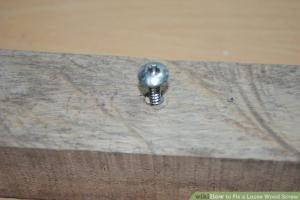Ultimate Guide: How to Fix a Loose Screw That Won’t Tighten in Wood

-
Quick Links:
- Introduction
- Understanding Loose Screws
- Common Causes of Loose Screws in Wood
- Tools and Materials Needed
- Step-by-Step Guide to Fix a Loose Screw
- Case Studies and Real-World Examples
- Expert Insights
- Conclusion
- FAQs
Introduction
Dealing with a loose screw in wood can be a frustrating experience, especially when it disrupts the structural integrity of your furniture or fixtures. Whether it’s a chair, a cabinet, or any wooden structure, a screw that won’t tighten can lead to wobbling, instability, and potential damage. In this comprehensive guide, we will delve into the methods, tools, and techniques to effectively fix loose screws in wood. This article is designed for both novices and seasoned DIY enthusiasts, providing a step-by-step approach that ensures success.
Understanding Loose Screws
A loose screw in wood is more than just an annoyance; it can indicate underlying issues such as wear and tear, improper installation, or even the wrong type of screw for the job. Understanding why screws become loose in the first place is crucial for effective repair.
Common Causes of Loose Screws in Wood
- Wood Compression: Over time, wood can compress around screws, leading to looseness.
- Wrong Screw Size: Using screws that are too short or too thin can prevent a secure fit.
- Frequent Use: Areas subject to movement or stress can cause screws to work loose.
- Moisture Damage: Wood can swell and shrink with moisture levels, affecting screw tightness.
Tools and Materials Needed
Before you start fixing a loose screw, gather the following tools and materials:
- Screwdriver
- Wood glue
- Wood filler or matchsticks
- Drill with drill bits
- Clamps (optional)
- Sandpaper
Step-by-Step Guide to Fix a Loose Screw
Follow these detailed steps to fix a loose screw in wood:
Step 1: Assess the Damage
Determine how loose the screw is and if there is any visible damage to the wood around it.
Step 2: Remove the Loose Screw
Using the appropriate screwdriver, carefully remove the loose screw from the wood.
Step 3: Evaluate the Hole
Examine the screw hole to see if it is stripped or damaged. If the hole is too large, you’ll need to fill it.
Step 4: Fill the Hole (if necessary)
Use wood filler or matchsticks dipped in wood glue to fill the hole. Allow it to dry completely.
Step 5: Reinsert the Screw
Once the filler has dried, reinsert the screw and tighten it securely.
Step 6: Test the Stability
After tightening, test the stability of the fixture or piece of furniture. Ensure that it is secure and does not wobble.
Case Studies and Real-World Examples
To illustrate the techniques discussed, let’s explore a few real-world scenarios:
Case Study 1: Fixing a Wobbly Dining Chair
A homeowner struggled with a dining chair that rocked due to a loose screw. By following the guide to fill the stripped hole, they successfully restored stability, showcasing the effectiveness of this method.
Case Study 2: Repairing a Bookshelf
An enthusiastic DIYer faced a similar issue with a bookshelf. By using the wood glue method combined with matchsticks, they reinforced the screw hole, ensuring it could hold the weight of heavy books without loosening.
Expert Insights
Experts recommend regular maintenance checks on wooden furniture to prevent screws from becoming loose. A little preventative care, such as tightening screws periodically, can save you from larger repair tasks down the line.
Conclusion
A loose screw in wood doesn’t have to spell disaster. With the right tools and techniques, you can easily fix the problem and restore stability to your furniture or fixtures. Remember to assess the damage, fill any oversized holes, and reinsert screws to ensure a secure fit. Regular maintenance can help prevent future issues.
FAQs
- What should I do if the screw hole is stripped? You can fill the hole with wood filler or matchsticks coated in glue, then reinsert the screw.
- Can I use super glue to fix a loose screw? Super glue is not recommended as it may not hold under stress; use wood glue instead.
- How often should I check my screws for tightness? It’s a good practice to check screws every few months, especially on frequently used furniture.
- What type of wood filler should I use? Choose a wood filler that matches the type of wood and is appropriate for indoor or outdoor use.
- Is it possible to overtighten a screw? Yes, overtightening can strip the hole further or damage the wood.
- Can I use a larger screw to fix a loose screw? Yes, a larger screw can work if the hole is filled appropriately.
- What if the screw keeps loosening? Consider using a thread-locking adhesive or consult a professional.
- Do I need special tools for this repair? Basic tools like a screwdriver and drill are usually sufficient for this repair.
- How can I prevent screws from becoming loose? Regular maintenance, using the right screw sizes, and avoiding moisture exposure can help.
- When should I consult a professional? If the structural integrity of the wood is compromised, it’s best to consult a professional.
Random Reads
- How to get a dog in gta v
- How to get a bike in pokemon red
- How to download video files with vlc media player
- How to delete text messages from an iphone
- How to delete thumbs db files
- How to remove unneeded unused files windows 10 11
- How to align garage door sensors
- How to align something in html
- How to remove user ps4
- How to remove virus from flash drive